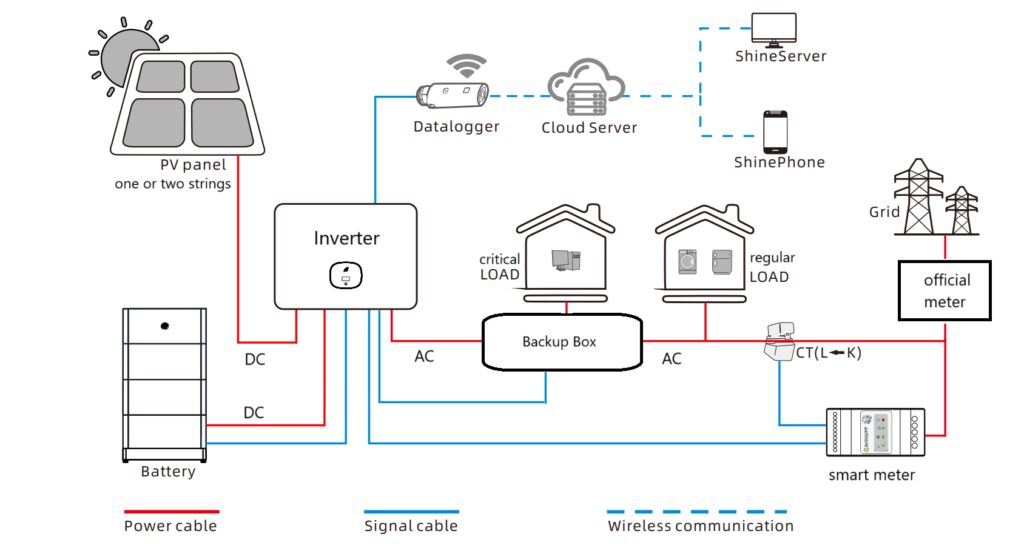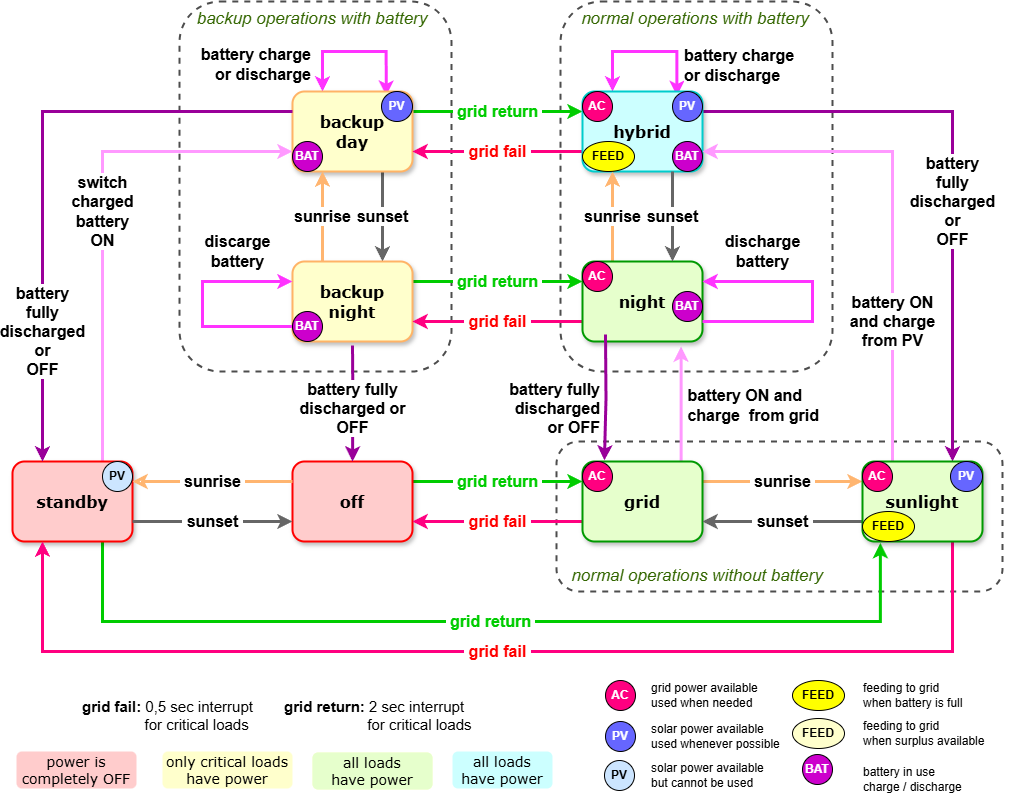ES-Hybrid is based on Growatt products. For example, an ES-Hybrid-10-15 system consists of the following components:
- 2 strings of solar panels (14 kWp in total)
- MOD-10KTL3-XH BP inverter
- SYN50 XH 30 backup box
- Shine RF Stick and LAN Box
- Smart Meter TMP-CT-E or classic energy meter TPM-C
- APX battery stand
- APX BMS
- 3 APX battery modules (5 kWh each)
The first number “10” is the rated power limit of the inverter in kW, the second number “15” is the real usable battery capacity. Typically you will connect panels with a significantly larger peak power sum to get the most out of your inverter. In the example above: 14kWp. An inverter rated at 10kW can handle excessive power as this usually only occurs during short periods of the day (if at all). The batteries of ES-Hybrid can be discharged to zero, which means that their nominal capacity is fully usable.
Terms and Definitions
At the top of the hierarchy is the USER, who can own one or more PLANTS, which consist of DEVICES. In our case by default the USER NAME is identical with the first PLANT belonging to that user.
INVERTERS are SOLAR DEVICES and ENERGY METERS are METERING DEVICES, wheras the BATTERY is seen as a part of an INVERTER. A Plant can have one or more DATA LOGGERS. In our case a DATA LOGGER is a Shine LAN Box, which may connect to several RF_STICKS which are part of the INVERTERS.
The general structure is like this:
easy-solar.eu
user_A USER
plant_B PLANT
device_C DEV:INVERTER
bat_C BATTERY
stick_C RF_STICK
device_D DEV:INVERTER
stick_D RF_STICK
logger_E (->C1,D1) LOG:LAN_BOX
plant_F PLANT
device_G DEV:INVERTER
bat_G BATTERY
stick_G RF_STICK
logger_H (->G1) LOG:LAN_BOX
meter_I DEV:ENERGY_METER
user_J USER
... ...
Because many users will have only one plant with one inverter we take the ID of the inverter and use it also as the name of the (first) plant and as the name of the user.
The operating mode
The idea is to use as much as possible of the harvested solar energy ourselves. This is mainly due to the fact that the revenue for1 kWh we feed into the net will typically be much less than what we have to pay for 1 kWh which we import from the grid.
Apart from protection against grid failure this price difference is the main justification to have a battery. Its size should be sufficient to satisfy the energy consumption of our building during non-sunlight hours for at least nine months. We are talking about nine months only because in winter there will not be enough energy to store. The battery will stay asleep for longer periods in that season – although there may be some wonderful sunny days in winter where the battery will be fully charged over day and discharged over night.
So “store for later use” is more or less identical with “store for using overnight”.

However, there are some countries which apply a “net metering principle” to their grid customers. In that case the only purpose of a battery is protection against grid fault and battery size should be chosen according to the expected duration of off-grid periods.
Wiring diagram
The following diagram shows the connections between the components.

Please study the diagram carefully. The DC cables from the panels are one or two pairs of red/black cable. The DC cables fro the inverter to the battery are red, blue and neutral. The AC cables are all 5 wires (3 phases, neutral and protectice earth). The blue lines are control cables using RS485 protocol (24V DC). Except the one that connects the Datalogger to the inverter (which is USB). The upper right part of the diagram is somewhat simplified. In reality you will find there also the Growatt LAN box connected via etherent cable to your internet router.
The following diagram is essentially the same but a little bit more technical. Your electrician will underdstand it.

State Changes of an ES-Hybrid System
There are several factors which influence the state and behavior of an ES-Hybrid system.
- Whether there is sunlight or not
- Whether the power grid is available or not
- Whether the battery is charged or not
- Whether the loads need more current than the solar panels can deliver
- Whether the loads need more current than the battery can deliver
- Whether the loads need more current than panels and battery can deliver together
- Whether the battery can take more power for charging than the difference of solar power and load demands
- How much grid feeding is allowed
- .. and others …
The basic strategy is to use solar power whenever possible and use it according to three priorities: (1) fulfill load demand, (2) charge battery, (3) feed surplus into grid.
Events like grid failure and grid return change the state of the system. The following diagram gives an idea of what can happen:

Installation
Inverter and Meter:
Backup box:
Battery: